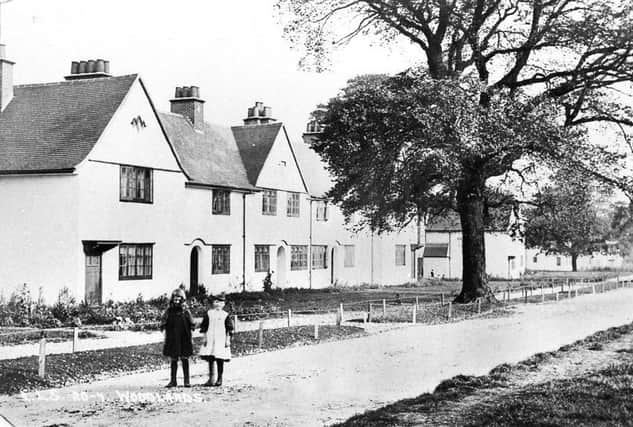Nostalgia on Tuesday: Model Living


He was referring to the new ‘model’ colliery village Woodlands, which was built adjacent to the new pit, Brodsworth Colliery, four and a half miles north of Doncaster.
Arthur Markham (later Sir Arthur Markham) was the man behind the colliery and model village project, forming the Brodsworth Main Colliery Co. He had secured a lease from Brodsworth Hall owner Charles Thelluson, covering an area of 6,000 acres.
Advertisement
Hide AdAdvertisement
Hide AdOn October 23, 1905, a group of dignitaries gathered on the Brodsworth estate to witness the turning of the first sod by Mr Thelluson for the colliery that would provide work for more than 3,000 men.
Sir Arthur was determined to house miners and their families under the best conditions. Consequently, Woodlands was an example of a private village built expressly to house the people working for a colliery company.
The village was designed by Chesterfield architect Percy B Houfton during 1907-08. Houfton was influenced by the industrial community ideals of the late 19th century and the emerging Garden City Movement, and Woodlands became an early and influential town-planning scheme.
Though the private property of the company, the village was intended to pay its way and, at the rental charge, it was expected to bring in a return of four per cent on the capital after everything – including ground rent, rates and maintenance – was paid.
Advertisement
Hide AdAdvertisement
Hide AdWoodlands was built in two phases and included primary and secondary schools, two places of worship, a health centre and church hall. The community buildings were centrally situated between the two phases to provide education and a deeper sense of spiritual values.
The first part to be developed –known as The Park – contained 121 cottages, at a density of five to the acre, overlooking a 24-acre green, surrounded by well-established trees.
Phase two, the larger portion of the site – The Field, comprising 532 cottages, was one of greater density, around a ‘horseshoe’ crescent with central and radiating avenues.
The village’s principal feature was its main avenue, planted with a quadruple row of trees, along with numerous open spaces. A criticism made to the designer was that the scale of the streets and open spaces were sometimes too great and the cottages were apt to look lost in its width. Houfton recognised this incongruity and felt that his reaction to the mean and cramped streets in other industrial areas had probably been carried to excess in the other direction.
Advertisement
Hide AdAdvertisement
Hide AdNineteen different styles of architecture were represented in the houses, to avoid the monotony and uniformity of terraced housing. Houfton planned the house types so that all principal living rooms and bedrooms received all possible sunshine, at some time during the day. This even applied to north-facing properties with ‘through’ living rooms. Larders were north-facing and all windows ‘opened’, even on staircases, to ensure cross-ventilation. The combination of all these features meant that Houfton’s artisans’ houses were some of the best houses built for £150-£200.
Initially, the living room and bathroom cottages were rented at 6s 3d (33p) per week; the living room and bath-in-scullery cottages at 5s 9d (29p); and single living room cottages at 5s (25p).
In 1912 while on a visit to Yorkshire, King George V and Queen Mary visited Woodlands, where they were greeted by Charles Thellusson. The purpose of the visit was to view a collier’s house and they toured the home of coal-getter William Brown, at 33 The Park.
East of the model village, along the Great North Road, a group of shops, a cinema and a public house were eventually built.
Advertisement
Hide AdAdvertisement
Hide AdIn an effort to secure good relations with colliers, Arthur Markham took up residence in the village, and the early years seem to have been marked by lengthy discussions about all problems and the creation of committees of workmen to organise the life of the village. Although such affairs were under the control of the tenants, Arthur Markham maintained overall direction, and he allowed no interference from outside authorities. He said that when they, the owners, had a model village, they must have autocracy, they could not have democracy. If model villages were laid out by one man, one man must have control of them.
The ownership of the Woodlands estate passed to the National Coal Board when the coal industry was nationalised, and then to Doncaster Metropolitan Borough Council. The quality of the estate was recognised by the council in 1978 when it was declared a conservation area. Ten years later the Department of the Environment announced that 60 houses out of 653, along with four principal community buildings, warranted listed building status, as they were of national importance.
At Brodsworth Colliery’s jubilee celebrations in 1955, it was noted that more than 47 million tons of coal had been raised up the shafts. Predictions were also made that the colliery had a secure future as there was still enough coal to last more than 100 years at the rate of 40,000 tons per week. Sadly, this prediction was not to be as, on September 7 1990, Brodsworth colliery closed. By October 1992 the site was cleared and later formed the Brodsworth Community Woodland.